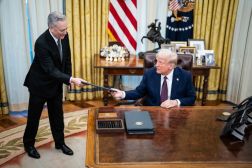AI talent wanted: The federal government is searching far and wide to fill new cutting-edge positions

As the White House moves forward with the implementation of its executive order on artificial intelligence, a shortage of domestic workers skilled in AI is creating opportunities for experts around the world to seek sponsored employment with the U.S. government.
The long-awaited order arrived with a laundry list of requirements for agencies, which are now tasked with growing the federal talent pool with workers who have experience in AI research, development, procurement and deployment.
To fill that pool, the Biden administration is “putting a lot of emphasis on bringing in talent from everywhere,” White House Office of Science and Technology Policy Director Arati Prabhakar said in an interview with FedScoop, underlining the importance foreign nationals will play in getting the federal government up to speed on AI.
The executive order’s callouts to boost the AI workforce within federal agencies “is just the next chapter of a long American story of people, American kids going into science and technology and making huge contributions,” Prabhakar said. “Also coupled with being able to attract some amazing talent from around the world and who come here for these tremendous opportunities in our country. [White House officials] very much want to make sure both of those continue to happen.”
At AI.gov, the Biden administration has highlighted both immigrant and nonimmigrant pathways for foreign nationals to bring their knowledge of AI to the federal government.
And in cases where agencies face challenges in the form of lengthy hiring processes or other roadblocks for meeting workforce requirements laid out in the order, OSTP is providing “levers” to help, Prabhakar said. That includes AI-specific cohorts, created by the Presidential Innovation Fellows and the U.S. Digital Corps, bringing talent from the private sector to the public sector.
Lynne Parker, a former deputy U.S. chief technology officer who assisted with the Trump White House’s 2020 executive order that called on agencies to annually create AI use case inventories, said in an interview with FedScoop that there is a “shortage” of AI talent. There’s also the challenge, Parker added, of the government competing for AI talent with industry, where individuals are able to solve “interesting problems” for higher pay.
“If you’re going to be training the talent in our universities here, then obviously it makes a lot of sense for us to try to recruit them to stay here to benefit the United States,” Parker said. “Since there’s such a huge shortfall of talent, I think there’s that emphasis on immigration, [which] is a recognition of the fact that … a high percentage of people who are getting that expert-level training [in AI] are coming from overseas. That’s where I think the most immediate pipeline of available talent is.”
Parker said it’s possible that “many Ph.D. graduates would like to go into academia, but they may feel like it’s too difficult to get the research funding that they need in order to be successful.” But if funding were available to train more students, and funding was easier to attain, then individuals may be more inclined to go into academia to train the next generation, she said.
Prabhakar, meanwhile, noted the various open roles for AI across the government makes clear the “need to learn how to use this powerful technology in really creative ways that are deeply responsible as a great way for government to lead by example in the use of AI.”
“We were thrilled with the response to the AI talent surge when the executive order came out,” she added. “Just an enormous volume of wonderful resumes that came in — people who have built all the data systems and the computational capacity that you have to have [in order] to use AI intelligently.”
OSTP is trying to leverage effective tech talent programs deployed over the past decade to bring more tech-centric skills into government, Prabhakar said, with the aim of providing those interested in working on AI with more opportunities in federal agencies.
The feedback from agencies on the EO’s actions, including workforce requirements, has so far been positive, according to Olivia Zhu, a senior policy adviser with OSTP. In an interview with FedScoop, Zhu said the White House is “super optimistic that we’ve gotten a really large influx of interest from the public.”
“When we were creating this executive order, the president directed the team to pull every lever,” Zhu said. “The feedback is reflecting our intentions of understanding that AI has such broad applications in various areas, right from the workforce to the use in government, to ensuring that we have safety standards.”
This article was updated Dec. 22, 2023, with quotes from OSTP’s Olivia Zhu.






